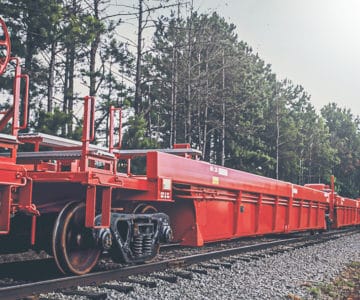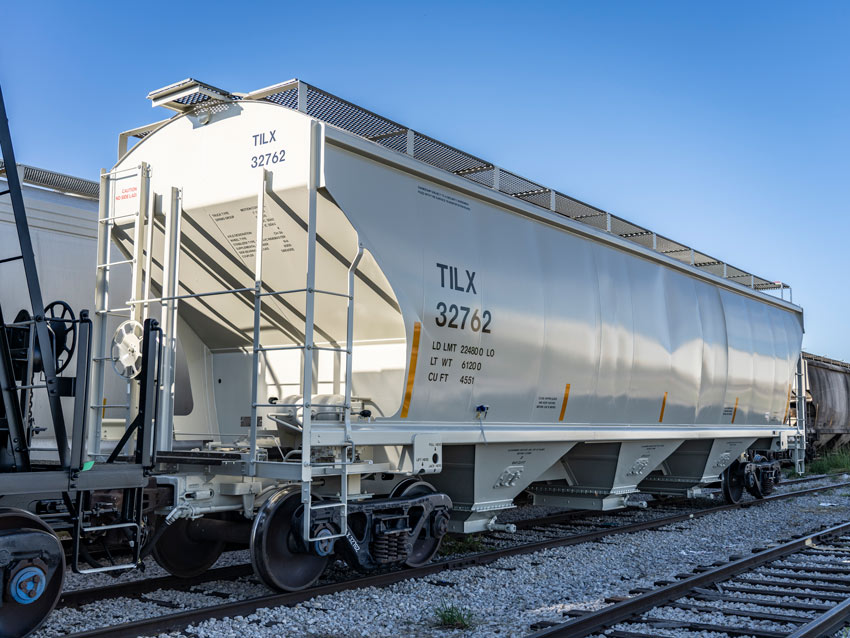- Products
-
Services
- Innovation
- Solutions
- Maintenance
- Parts
- Leasing
From freight rail’s inherent environmental advantages to TrinityRail’s progress in the development of more environmentally friendly solutions, sustainability has never been so top-of-mind. As organizations across all industries look for ways to reduce the environmental impact of their supply chain, leaders like TrinityRail are charting the course forward and leveraging new technologies.

TrinityRail strives to spotlight the environmental benefits of rail shipping, using our suite of services and solutions to make the sustainable choice the easy choice. We’ve also been actively engaged in research to quantify the environmental difference freight rail can make when shippers use it more prominently in their supply chain strategy.
These metrics and comparative statistics bring into focus just how big an impact freight rail has on sustainability efforts. All statistics are sourced from the Association of American Railroads.
Though freight rail represents 40% of the long-distance shipping industry, rail shipping is only responsible for 1.9% of greenhouse gas emissions. It’s estimated that when a shipper moves their freight from trucking to rail, they reduce their emissions by 75%.
A single railcar can replace the load of three to four over-the-road trailers while operating on a fraction of the fuel. Put numerically, rail shipping can move 1 ton of freight over 480 miles on a single gallon of diesel fuel. That’s a level of fuel efficiency and asset utilization that other shipping modes can’t match.
Through scrap and salvage efforts like TrinityRail’s Sustainable Railcar Conversion Program, freight railcars can achieve high amounts of recyclability. This, combined with a longer product lifespan, reduces raw material usage and manufacturing frequency — reducing overall emissions in turn.
Railcars are more resilient, fail less often, and are more easily maintained than other modes of transportation. For all of these reasons, freight rail is more sustainable due to the lifespan of each railcar. While trucks used for long-distance freight average a life of 12-15 years, a freight railcar can last for 35-50 years when properly maintained and has parts that can be recycled and repurposed.
We have set out to be a leading voice in freight rail’s growing commitment to enhanced sustainability and environmental responsibility. Our efforts include the development of new, more sustainable railcar products; the creation of new services and solutions that elevate efficiency and amplify sustainability; and the introduction of overhauled processes and procedures that work in unison to both track and reduce our impact.
Environmental Management
System Certification
Production Safety Award
From the American Chemistry Council
For TrinityRail’s Hourglass™ autorack and driving continuous improvement in chemical product safety.
Awarded to TrinityRail’s Mexico Facilities
From PROFEPA
Procuraduría Federal de Protección al Ambiente
From the American
Chemistry Council
Waste Minimization, Reuse, and Recycling
From the American Chemistry Council
For TrinityRail’s efforts in pursuing low-VOC coating options to reduce VOC emissions.
OCS Partner & Pledge Taker
Implementing practices for zero pellet, flake, and powder loss, and helping control plastic resin loss worldwide.
By developing innovative solutions and participating in forward-thinking collaborative initiatives, we can not only drive enhanced sustainability in freight rail, but also make it more efficient and effective for shippers. With products like the Trinsight® logistics platform and participation in collaborative efforts like RailPulse™, TrinityRail is helping to lead rail shipping into the future.
Through this program, select railcars are reengineered and repurposed to reduce waste and save energy during production and their materials can be leveraged into new rail products. The TrinityRail SRC® initiative has saved over 79 million pounds of raw materials through 2023.

Through this program, select railcars are reengineered and repurposed to reduce waste and save energy during production and their materials are immediately leveraged into new rail products.
Sustainability innovations and environmental initiatives are only as good as the results they produce. To keep our finger on the pulse of progress, TrinityRail has expanded our tracking capabilities to measure many relevant pieces of the sustainability puzzle.
Transforming all U.S. painting facilities to EPA-defined Minor Source emission levels.
Our innovative robotic railcar cleaning technology, TERSUS, reduces water use through superior force, precision, and by treating and reusing water. The robotic cleaning system improves worker safety by eliminating human entry to clean tank cars for many commodity types.
TrinityRail has reported on Scope 1 and 2 greenhouse gas emissions for the past three years, and has shown intensity reductions over that time. We are committed to continuing our energy consumption reduction efforts, as well as exploring renewable energy options.
Improving energy efficiency of operations. TrinityRail conducts regular audits to identify repairs and other opportunities to improve energy efficiency.
TrinityRail’s waste-to-landfill reduction program is on pace to meet our goals, and we are committed to growing this program in order to continue to reduce our environmental footprint.
In 2021, we built a new platform utilizing business analytics to provide real-time, in-depth visibility to GHG emissions, energy use, water use, and hazardous waste, among other key metrics across the enterprise. In 2022, we saw increased awareness, ownership, and problem-solving concerning sustainability efforts with this enhanced data visualization and transparency.